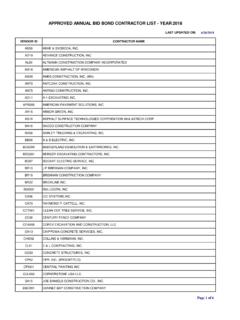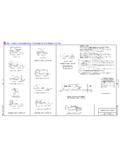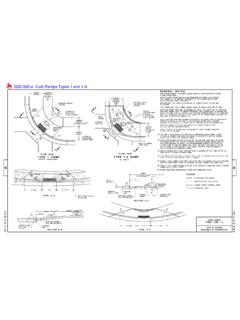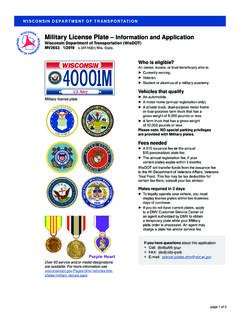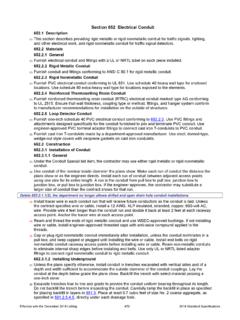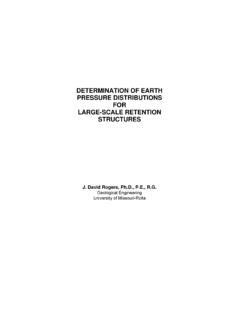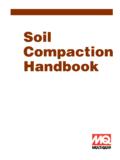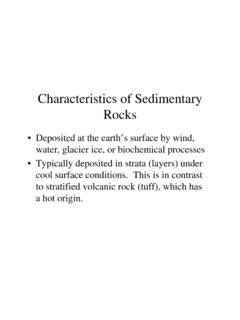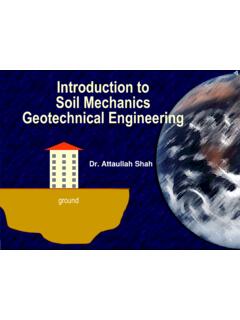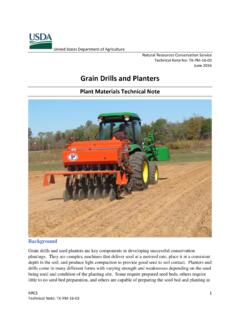Transcription of Effective Depth of Soil Compaction
1 Effective Depth of soil CompactionThe Wisconsin Department of Transportation (WisDOT) spends approximately 10 percent of its improvement project budget on embankment construction each year. A critical aspect of embankment construction is stability. It is needed to provide an acceptable foundation for pavement construction and will contribute to the long-term performance of the pavement structure. To achieve this, WisDOT developed specifications for embankment density and has developed specifications to limit the thickness of embankment lifts placed during construction.
2 The current specifications limit lift thickness to meters (8 inches) for most soil conditions. However, if granular soils are used and density measurements are being made, a (12-inch) lift thickness may be allowed. The 8-inch lift limit is by far the most common application on departmental projects. The (8-inch) lift limit has been the standard for WisDOT construction for many years. This limit was based on practical field experience with contractor methods and equipment. It has been accepted as a reasonable soil thickness that would contribute to adequate embankment Compaction without excessive testing and inspection by WisDOT is the problem?
3 Limiting lifts to meters (8 inches) has a direct impact on contractor time and cost for embankment construction. WisDOT does not have the staff to closely monitor embankment construction. As a result, it is not uncommon to see embankment lifts of more than meters (8 inches) on many WisDOT projects. This has raised concerns about the adequacy of embankment Compaction . However, modern earthmoving and Compaction equipment, with much larger footprints and weight, could potentially compact thicker soil layers without sacrificing mechanical performance of embankments and reduce construction costs.
4 Therefore, WisDOT needs to examine the specification to maintain the required (8-inch) lift limit for embankment Conduct theoretical analyses to relate degree of soil Compaction at various depths below the surface to energy applied to the surface. 2. Develop a system to monitor energy received and degree of Compaction achieved at various depths under actual field Develop processes to determine the influence of basic soil parameters such as texture, plasticity and moisture content on energy dissipation and Compaction Develop recommendations to optimize lift thickness with practical considerations for equipment availability and delivered series of field monitoring, testing.
5 And numerical studies were used to evaluate the response of soils during Compaction operations at various depths under the action of a smooth-drum vibratory roller, rubber-tired roller, padfoot roller and scraper. Different soil property profiles were used to assess the effectiveness of various Compaction methods, including shear-induced displacement and rotation monitoring using micro electro-mechanical systems (MEMS) accelerometer, dynamic cone penetrometer (DCP), soil stiffness gauge (SSG), pressure plate, sand cone, nuclear density gauge (NDG) and P-wave propagation.
6 Numerical modeling utilizing a hardening soil model was used to expand the results of the Compaction effectiveness in FrattaUniversity of 0092-08-11 Wisconsin Highway Research Program (WHRP) May 2015 Instrumented soil layer by MEMS accelerometersThis brief summarizes Project 0092-08-11, Effective Depth of soil Compaction in Relation to Applied Compactive Energy Wisconsin Highway Research ProgramResults For coarse-grained soils, loose lift thickness up to meters (16 inches) performed well in all tested parameters (including soil particle rotation, dynamic cone penetration and nuclear density gauge).
7 However, the interpretation of the SSG modulus at the near surface and P-wave-based modulus at the bottom of thick lift layers provided evidence of under- Compaction regions at the bottom of lifts in coarse and fine-grained soils. These data justify setting maximum limits of meters (16 inches) on loose-lift thickness even though for most coarse grained soils the use of large equipment appears to be Effective in compacting thick lifts. For fine-grained soils, the data are not as definitive. However, nuclear density gauge results from two different sampling depths do not appear to show a detrimental effect for the tested loose lift thickness at different water contents and for different Compaction equipment.
8 These results are also confirmed by the results from dynamic cone penetration testing where, for all conditions, the meters (12 inches) showed overall the maximum shear strength along the Compaction profiles in all but one of the tested cases. Tire-based roller and earthmoving equipment ( , scraper) provided higher contact pressures. These high pressures propagate deep into the soil mass and allow the Compaction of thick layers. However, this type of roller may produce uneven Compaction regions ( , zones that were under-compacted).
9 When the compactor missed the path above the pressure plate, pressure responses were lowered. This suggests the importance of the area coverage in the compacted plane using tire-based soil compactors. Therefore, WisDOT officials and contractors need to be careful offsetting passes to equally compact all of the Compaction area and effectively compact lifts. Shear-induced rotation measurements provide indication of soil particle movements. Rotation movements are dependent on the type of soil and Compaction equipment used.
10 These observations imply that the current conservative lift thickness specification in coarse-grained soils may be increased by well-controlled Compaction equipment and water contents of of numerical modeling have shown: The Compaction process is a function of compactor s weight, soil type and contact width of the wheel loading. Using various contact widths, the research team simulated the effect of the wheel load moving during Compaction processes. A hardening soil model was implemented to simulate the Compaction process using volumetric hardening (cap hardening) and deviatoric hardening (shear hardening).

